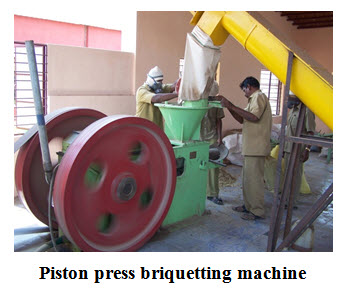Site pages
Current course
Participants
General
Module 1. Design and operational parameters
Module 2. Performance evaluation and maintenance a...
Module 3. Performance evaluation and maintenance a...
Module 4. Performance evaluation and maintenance a...
Module 5. Performance evaluation and maintenance a...
Module 6. Performance evaluation and maintenance a...
Module 7. Biodiesel utilization in CI engines
Lesson 24. Briquetting Systems
Briquetting technologies used in the briquetting of the agro residues are divided into three categories. They are (i) high pressure or high compaction technology, (ii) Medium pressure technology and (iii) low pressure technology. In high pressure briquetting machines, the pressure reaches the value of 100 MPa. This type is suitable for the residues of high lignin content. At this high pressure the temperature rises to about 200 - 250o C, which is sufficient to fuse the lignin content of the residue, which acts as a binder and so, no need of any additional binding material. In medium pressure type of machines, the pressure developed will be in the range of 5 MPa and 100MPa which results in lower heat generation. This type of machines requires additional heating to melt the lignin content of the agro residues which eliminates the use of an additional binder material. The third type of machine called the low pressure machines works at a pressure less than 5 MPa and room temperature. This type of machines requires addition of binding materials. This type of machines is applicable for the carbonized materials due to the lack of the lignin material.
1. High Compaction Briquetting technologies
The two major types of binder less or high compaction technologies used for briquetting of agro residues are: (i) piston press (ram and die) technology and (ii) screw press technology. In the piston press type, the biomass is extruded through a die by a reciprocating ram at a very high pressure. In the screw press type, the biomass is extruded continuously by a screw through a heated taper die.
1.1. Piston press technology
Most of the briquetting machines installed in

1.2. Screw press technology
This technology was invented and developed in
2. Comparison between piston press and screw press
In a piston press the wear of the ram and die is less compared to the wear of the screw and die in a screw extruder press. The power consumption in the former is less than that of the latter. But in terms of briquette quality and production procedure screw press is definitely superior to the piston press technology. The central hole incorporated into the briquettes produced by a screw extruder helps to achieve uniform and efficient combustion and, also, these briquettes can be carbonised.
Comparison of piston press and screw extruder
|
Parameters |
Piston press |
Screw press |
|
Optimum moisture content of raw material |
10-15 % |
8-9 % |
|
Wear of contact parts |
Low in case of ram and die |
High in case of screw |
|
Output from the machine |
In strokes |
Continuous |
|
Power consumption |
50 kWh/ton |
60 kWh/ton |
|
Density of briquette |
1 – 1.2 g/cm3 |
1 – 1.4 g/cm3 |
|
Maintenance |
High |
Low |
|
Combustion performance of briquettes |
Good |
Very good |
Source: FAO of the United Nations,
3. Briquetting Process
The series of steps involved in the briquetting process are (i) collection of raw materials (ii) preparation of raw materials (iii) compaction and (iv) Cooling and Storage.
3.1. Collection of raw materials
In general, any material that will burn but is not in a convenient shape, size or form to be readily usable as fuel is a good candidate for briquetting.
3.2. Preparation of raw materials
The preparation of raw materials includes size reduction, drying, mixing of raw materials in correct proportion, mixing of raw materials with binder etc.
3.2.1. Size reduction
The raw material is first reduced in size by chopping, crushing, breaking, rolling, hammering, milling, grinding, cutting etc. until it reaches a suitably small and uniform size
(1 to 10 mm). For some materials which are available in the size range of 1 to 10mm need not be size reduced. Since the size reduction process consumes a good deal of energy, this should be as short as possible.
3.2.2. Drying
The raw materials are available in higher moisture contents than what required for briquetting. Drying can be done in open air (sun), with a heater or with hot air. Drying can be done either before or after drying.
3.2.3. Raw material mixing
It is desirable to make briquettes of more than one raw material. Mixing will be done in proper proportion in such a way that the product should have good compaction and high calorific value.
3.2.4. Mixing of raw materials with binders
Mixing of raw materials with binders in correct proportion is important for the production of briquettes of good compaction. This is best accomplished by a trial and error method of making several briquettes with different mixtures of biding material and testing each for mechanical strength and burning characteristics. The cost of binding material can be critical to the economic success of the project. Natural or synthetic resins, tar, animal manure, molasses, ligno-sulphonates, sewage mud, fish waste, algae, starch, slime, clay, mud and cement are some of the binders used in briquetting process.
3.3. Compaction
Compaction process takes place inside the briquetting machine. The process depends on the briquetting technology adopted.
3.4. Cooling and Storage of briquettes
Briquettes extruding out of the machines are hot with temperatures exceeding 200oC. They have to be cooled and stored.